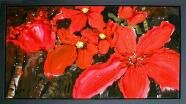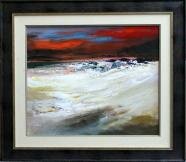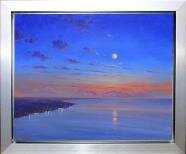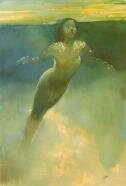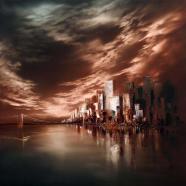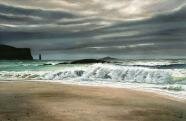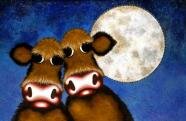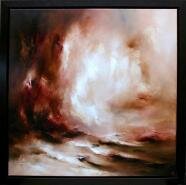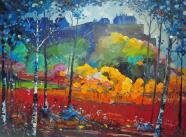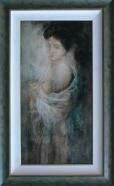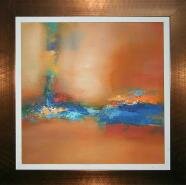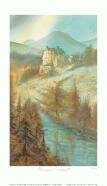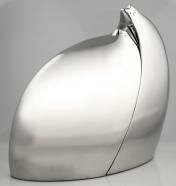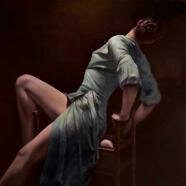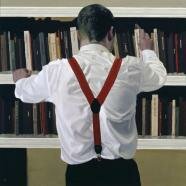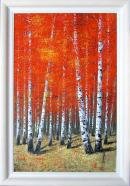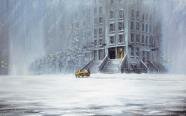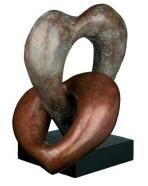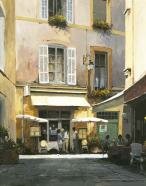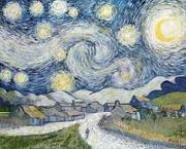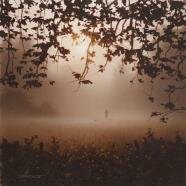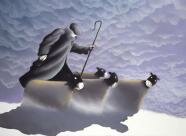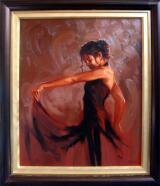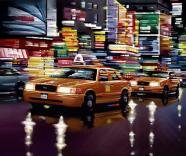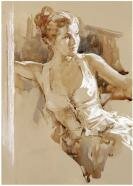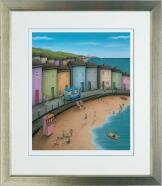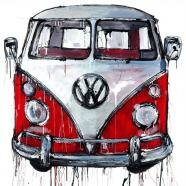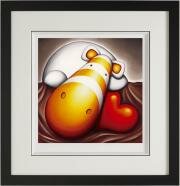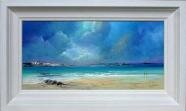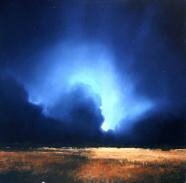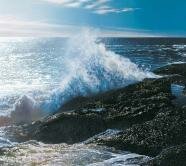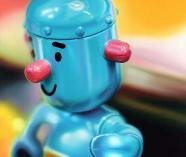“Draw me some jungle animals.” said my infant school teacher. At the tender age of 6, I was excused from assembly for a whole week in order to draw animals for her ambitious ‘Jungle Frieze’. I drew and drew and the results were impressive. The curious combination of lions, tigers, kangaroos, pandas and chimps plus many more assorted animals inhabiting the same jungle didn’t seem to worry her as her frieze was fully populated.

I was born in Chesterfield, Derbyshire (of ‘crooked spire’ fame) in 1959 and have been told I could always draw. When I was young, I was lent a beautifully illustrated edition of ‘The Jungle Book’ by a neighbour. For months I religiously copied the exquisite pen and ink drawings of animals which adorned its pages. I made a portfolio from card and wrote ‘NICK POTTER, ARTIST. KEEP OUT ‘on the front. It seems all I have ever wanted to be was an artist. Unfortunately life doesn’t always give you what you want, well not immediately anyway.
I enjoyed a comfortable and happy childhood. My father worked in a steel factory, my mother was a teacher. Both worked hard to provide for me and my two younger sisters. During my secondary education at Netherthorpe Grammar School I engaged in a wide variety of activities and sport. As a fairly strict school, blazers were to be worn at all times, except for sport and in the art room. I was very good at games and art. I was the only pupil in my year taking ‘A’ level Art. I therefore received one to one tuition from my art teacher Bob Widgery, a kind and talented Welshman who was a friend rather than a teacher. Our paths still cross. He was very encouraging and taught me to observe rather than see. My then girlfriend Gillian was a talented artist with a style of her own. She taught me lots including the art of watercolour. I sold my first painting to my headmistress for £10. She wryly suggested I might invest some of it in a razor!
Despite attaining an ‘A’ at A Level I was encouraged to go to University rather than Art School as this would give me ‘proper qualifications’ I went to Leicester University and read Archaeology. Although I continued my art most of my time was taken up with student type activities such as beer, girls and sport- oh, and of course study.
On leaving University I did a P.G.C.E course and reluctantly went into teaching in Chesterfield. This didn’t work and I got a job as an Educational Publishing Rep. My wife and I then moved to the beautiful village of Great Bowden in the heart of the Leicestershire countryside. Living in the country and fuelled by frequent visits to Cornwall, Scotland and the Lake District I became much more interested in Landscape painting. I sketched prolifically and painted watercolours and even exhibited at various galleries and in exhibitions. I longed to paint loose watercolours like Edward Seago or Edward Wesson but failed. My style was more like a cross between James Fletcher-Watson and David Bellamy. I became very frustrated, despite illustrating a couple of children’s books and a cookery book.
In 1988, when my two children were young I moved back to Derbyshire. The responsibilities of parenthood and a mortgage have always made me cautious. Even when I was made redundant I still found the need to get another job. When my father died suddenly in front of me and my son Tom, it made me aware of the fragility of existence. I ached to do something more with my life. My frustration affected my relationships and eventually my wife and I amicably divorced. I bought a small cottage, turned the main bedroom into a studio and painted. I discovered the vibrancy of silk paints and used them like watercolours. My new partner, Natasha, was very keen for me to use my artistic talents. We bought a house together and she set up a company called ‘Altered Images’, selling my paintings and cards to outlets around Derbyshire. My youngest son, Dylan was born in 2001 which complicated things but my work proved to be very popular. ‘Treeline Gallery’ in Bakewell, gave me my first real break with a one man exhibition. I exhibited around 70 pictures, had a great preview and sold some paintings.
In 2003 Natasha and I had the opportunity to become partners in our own gallery, a dream come true. We launched Charisma Gallery in Matlock, Derbyshire.
I sold a lot of paintings and hundreds of cards in the gallery. Selling work to strangers in your own gallery is a real thrill. At this time I began to paint in acrylics on canvas with some success. Natasha ran the gallery. We made a lot of artist friends, held previews and exhibitions and attended events such as The Manchester Art Show. My eldest son Tom and daughter Alice helped us in the business. The success of my work in the gallery encouraged me to approach other galleries. I recently had work in 16 galleries from Scotland to Cornwall. Selling work in other galleries gave me a lot of confidence, as did the constant support of family and friends.
After experimenting with a new mixed media technique, I was encouraged by an artist friend to submit work to Washington Green. I had never thought of my work as being commercial but was excited when asked to show my work to Glyn Washington and even more excited when he liked it. I am delighted to be given the opportunity to show my work to a wider audience and to see my work in print. Thanks to Washington Green my dream of becoming an artist has been eventually realised.
Ideas & Inspirations.
I love wild landscapes. It is so easy to take the landscape for granted but open spaces are becoming more and more precious as man puts pressure on the earth’s resources. I love all landscapes from the flatlands of Norfolk to the wild coasts of Cornwall, Pembrokeshire and Northumberland; but I particularly love wild mountain landscapes as found in Scotland and The Lake District. Each of the elements in my pictures is important to me:
The Moon
Ancient beliefs that stars and planets were gods and their movements determined the fate of everything on earth.
A Cancerian by birth date; my sign is ruled by the moon, constantly going through phases-light to dark and everything in-between, being ruled by the environment, which can make or break and alter my moods.
My feelings are close to the surface yet often hidden beneath a hard exterior shell. Emotions run hot and cold, they ebb and flow like the tides-ruled by the moon.
The only natural satellite of earth, the moon is cyclic and has phases.
It is the only other planet to be visited by man.
It is the closest planet to earth and is linked with mythology, mysticism and love. Its gravitational attraction causes bulges on the earth’s surface.
This push-pull effect, affects the water more than the land and causes the movement of the tides and the weather.
It has a pale reflected light both from the sun and the earth and has a dark side.
The full moon is the beginning of a cycle or the end. The circle is a satisfying shape in the sky.
The Trees
Ancient and slow growing, trees are a link between earth and sky with roots and branches. A living thing that is important for the environment. A cycle of life that lays dormant, then gradually bursting forth with life. Sadder winter trees, bare and skeletal yet not dead- even in the dark a promise of new life.
Tall forming patterns in the landscape, offering shelter, sturdy yet vulnerable, flexible yet fragile.
The Fields
I have always been fascinated by our ancient past, much of which is buried. I have an archaeology degree. I have studied field patterns and settlements from the air which are not visible at ground level. The earth holds the secrets to our planet’s history; its layers are a historical calendar.
As the surface of the planet it suffers exposure, erosion, deposition. The surface has been worked by man for centuries, it has been scarred by man some times irrevocably, but left it often reclaims.
The fields in the landscape provide patterns, colour, texture that is touched by man yet not tamed.
Mountains
Primeval and ancient, they are the result of massive upheaval in the earth. The earth’s layers are exposed.
They are isolated, rugged, textured and mostly unpopulated. They have their own micro-climate. Dark, looming they give height and perspective, a backdrop, changing colours in the different lights, casting shadows. They are nearer the moon.
Farm Buildings
A symbol of Man’s interaction with the earth: good and bad. They are strongholds, often isolated surrounded by land, often dwarfed by the landscape, huddled together. They create field- boundaries, pathways, patterns, and colour. They represent a livelihood linked to nature. They are often the lightest part of the landscape creating chiaroscuro within a picture, a tension between Man and nature. They can also offer a refuge for Man and beast, warm, comfort, reassurance. They can evoke a nostalgic feeling of times past, a different, gentler way of life.
From Palette to Picture.
Wild landscapes are my inspiration. My pictures are amalgamations or distillations of remembered landscapes.
I paint in my garden studio. This is my space. I do not need natural light and usually have the blinds drawn and door shut. I like privacy when painting.
I used to paint to music or the radio. Currently I paint to books on tape or CD which I borrow from the library. These are unabridged and can last up to 17 hours. I am so attuned to this way of working that I cannot paint without them. They are as much a part of the painting process as the paint or canvas. Generally I paint on 36″ x 36″ square canvas. I find this size and shape pleasing to work on. My compositions are unusual in that all the detail occurs in a quarter or a fifth of the picture.
Having decided on the composition in a sketchbook I carefully but quickly sketch in the detail. All this planning is often covered by the first coat of paint.
I then decide on a ‘mood’ colour which will unify the painting; however the first coat of paint may be the exact opposite. I generally paint with acrylics. I find them versatile and like the quick drying properties.
I am too impatient to wait for oils to dry.
I like to use texture in my work. This can take different forms: impasto paint, gesso applied with a knife, texture paint, decorator’s filler or smoother internal wall plaster.
I sometimes use a crackle glaze between coats of paint which produces fissures in the surface of the paint. I sometimes use ‘negative texture’ where I scrape back paint to the surface of the canvas. I often like to dribble or squirt paint or ink using a pipette and then disperse the dribbles with a fine water spray. This can be very unpredictable but exciting. I also use a large variety of tools for paint application. I will use the largest brush I can get away with as this prevents fiddling; these are often house painters brushes. I also use artist’s brushes, stencil brushes for spattering, palette knives, scrapers, spatulas and trowels. I squirt paint with syringes and pipettes and can call on a collection of rollers, sponges, quills, sticks and tissues for blotting.
Most of the texture is in the foreground. I use it sparingly in the background as it tends to pull it forward and can ruin the balance of the picture.
The paintings evolve and develop during the process. Nothing is written in stone.
I like to leave the paintings around the studio for a few weeks until the temptation to make minor changes abates. Once photographed the pictures are signed, varnished and packed away.
Although I reuse similar subject matter, each new work is an exciting adventure; like setting off on a journey with no proper map just a few vague directions. I can never totally predict where I will arrive but after a few directional changes it will be somewhere close to my desired destination.
A day in the Life of…
My two older children Tom and Alice are away at university, however, Liam and young Dylan live at home with my wife Natasha and I. Their day starts early and therefore so does ours.
The last thing on my mind at night and the first thing I think of in the morning is the painting I am working on or about to start. However in the morning practicalities take precedence: breakfast and school for the children and work for Natasha. When possible I walk Dylan the half mile to school.
I virtually run back in anticipation of a days Painting. Armed with milk for my studio cooler (a birthday present from Natasha) and my mobile phone I head into the studio. I resent the need for the mobile but being incommunicado all day is not practical.
Over a cup of tea and my latest story playing on the CD, I peruse the current work or prepare to begin a new canvas. Once I begin I only pause to make tea or change CDs. I work quite messily once into my stride with paint and brushes everywhere. I do not eat during the day as I regard it as a waste of precious time. I paint until it is time to fetch Dylan from school. From then on domesticity takes over.
I sort Dylan a snack or get his tea and then prepare the evening meal and tidy up. When Natasha comes home we eat tea together. I rarely paint in the evening and usually spend it with the family apart from Friday night when I go to the pub with my mates.
It’s good to leave the work locked in the studio overnight. It creates excitement for the next morning-that first glimpse of the painting and either joy or despair. If I am feeling insecure about a picture I might manufacture an excuse to ‘fetch’ something from the studio and have a crafty peak.
I retire to bed with my head full of new ideas.

